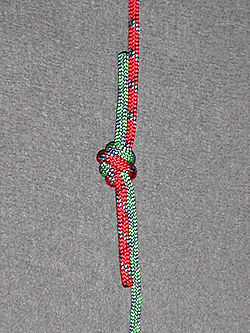Difference between revisions of "Translations:AY Honors/Abseiling/Answer Key/29/en"
From Pathfinder Wiki
(Importing a new version from external source) |
(Importing a new version from external source) |
||
| Line 1: | Line 1: | ||
<nowiki />{{ansreq|page={{#titleparts:{{PAGENAME}}|2|1}}|num=One2|dispreq=2}} | <nowiki />{{ansreq|page={{#titleparts:{{PAGENAME}}|2|1}}|num=One2|dispreq=2}} | ||
<nowiki />{{ansreq|page={{#titleparts:{{PAGENAME}}|2|1}}|num=One2a|dispreq=a}} | <nowiki />{{ansreq|page={{#titleparts:{{PAGENAME}}|2|1}}|num=One2a|dispreq=a}} | ||
| − | <nowiki />{{: | + | <nowiki />{{:AY Honors/Knot/Ring_Bend_Knot}} |
{{CloseReq}}<!-- One2a --> | {{CloseReq}}<!-- One2a --> | ||
Latest revision as of 14:25, 8 September 2021
2
Explain the uses of the following knots:
a
Tape
| Ring Bend (Water Knot, Tape Knot) |
|---|
|
Use: The water knot (or tape knot) is a knot frequently used in climbing for joining two ends of webbing together, for instance when making a sling.
The ends should be left at least three inches long and the knot should be "set" by tightening it with full body weight. The ends can be taped or lightly sewn to the standing parts to help prevent them from creeping back into the knot. Inspect the knot before each use.
How to tie:
|

